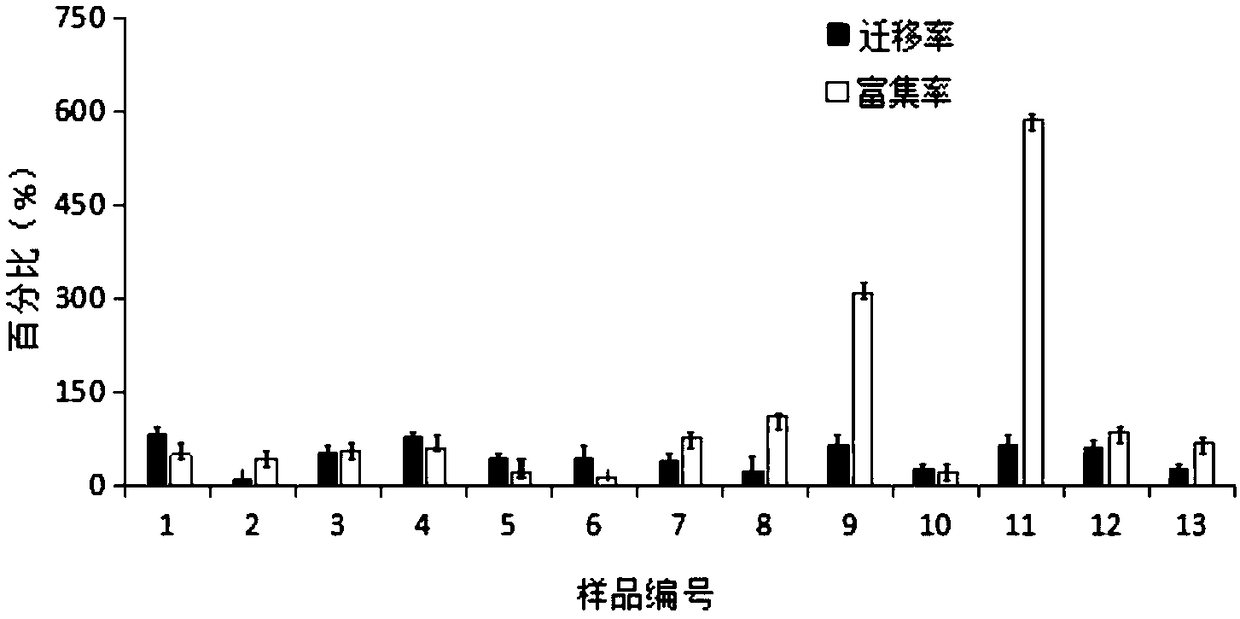Method for restoring arsenic-polluted soil by plant-microorganism combination
A combined remediation and arsenic-contaminated technology, applied in the field of soil remediation, can solve the problems of windmill grass that are rarely reported, and achieve the effects of water and soil conservation, strong environmental adaptability, and vigorous growth
- Summary
- Abstract
- Description
- Claims
- Application Information
AI Technical Summary
Problems solved by technology
Method used
Image
Examples
Embodiment 1
[0025] Example 1 Plant Screening
[0026] Select the herbaceous plants that grow well in a tailing mining area in Hechi City, Guangxi, ghost needle grass, southern mugwort, centipede grass, windmill grass, quinoa, bitter grass, ageratum, wood hibiscus, brick seedlings, big-leaved buddleia, ramie, For the genus Rushgrass and Plumeria, the roots and soil were dug up together, and 3 plants with similar plant heights were selected as parallel samples for each herb plant; each herb plant was separated from the rhizosphere soil on each herb plant, and each herb plant was obtained separately. Plant materials and various soil samples; air-dry each soil sample in a cool and dry place, pick out stones, put them into a mortar, grind them through a 0.15mm sieve and dry them for later use; clean each herb plant material separately, dry them, and measure The plant height and fresh weight are dried at 50°C for 48 hours, and the dry weights of the roots and aerial parts of each plant material...
Embodiment 2
[0046] Example 2 Microbial Screening
[0047] Under sterile conditions, 10 g of the pretreated soil sample with the highest arsenic concentration in Example 1 was added to 90 mL of sterile water containing glass beads, vortexed and shaken, and 1 mL was added to 9 mL of sterile water. Then dilute to a concentration of 10 -6 、10 -7 、10 -8 Then take 200 μL and spread it on LB solid medium, set up three replicates for each gradient, place them in a 37°C incubator and culture them, and pick single colonies with obviously different shapes to draw lines after the colonies grow out Cultivate and obtain 10 strains of primary screening bacteria with obviously different shapes, which are respectively marked as CP1-CP10, and the arsenic-containing LB medium without bacteria is used as a control, which is recorded as CK; the obtained primary screening bacteria CP1-CP10 are inoculated into LB Cultivate in liquid culture medium at 37°C and 180rpm for 12h, centrifuge at 10,000rpm in a ster...
Embodiment 3
[0053] Embodiment 3 plant-microorganism combined restoration
[0054] First, the microorganism CP3 in Example 2 was inoculated into 100 mL of LB liquid medium, and cultivated for 12 hours to obtain the CP3 bacterial liquid, which was set aside.
[0055] Add 1 kg of uncontaminated soil to the pot, followed by 1 mg·mL -1 arsenic standard solution, so that the concentration of arsenic in the potting soil is 5mg·kg -1 ,, planted the windmill grass with the same growth, and added 50mL prepared nutrient solution, slowed down the seedlings for 7 days, then took 20mL of CP3 bacterial solution and added it to the rhizosphere soil of the windmill grass, with the windmill grass without bacteria as a control, record For CK, each group was repeated three times, and then watered once every two days to maintain water content (the amount of water added was kept at 60% of the field water capacity), and 1 nutrient solution was added after 10 days. Remove, wash, and use 5mmol·L -1 The roots w...
PUM
 Login to View More
Login to View More Abstract
Description
Claims
Application Information
 Login to View More
Login to View More - Generate Ideas
- Intellectual Property
- Life Sciences
- Materials
- Tech Scout
- Unparalleled Data Quality
- Higher Quality Content
- 60% Fewer Hallucinations
Browse by: Latest US Patents, China's latest patents, Technical Efficacy Thesaurus, Application Domain, Technology Topic, Popular Technical Reports.
© 2025 PatSnap. All rights reserved.Legal|Privacy policy|Modern Slavery Act Transparency Statement|Sitemap|About US| Contact US: help@patsnap.com



